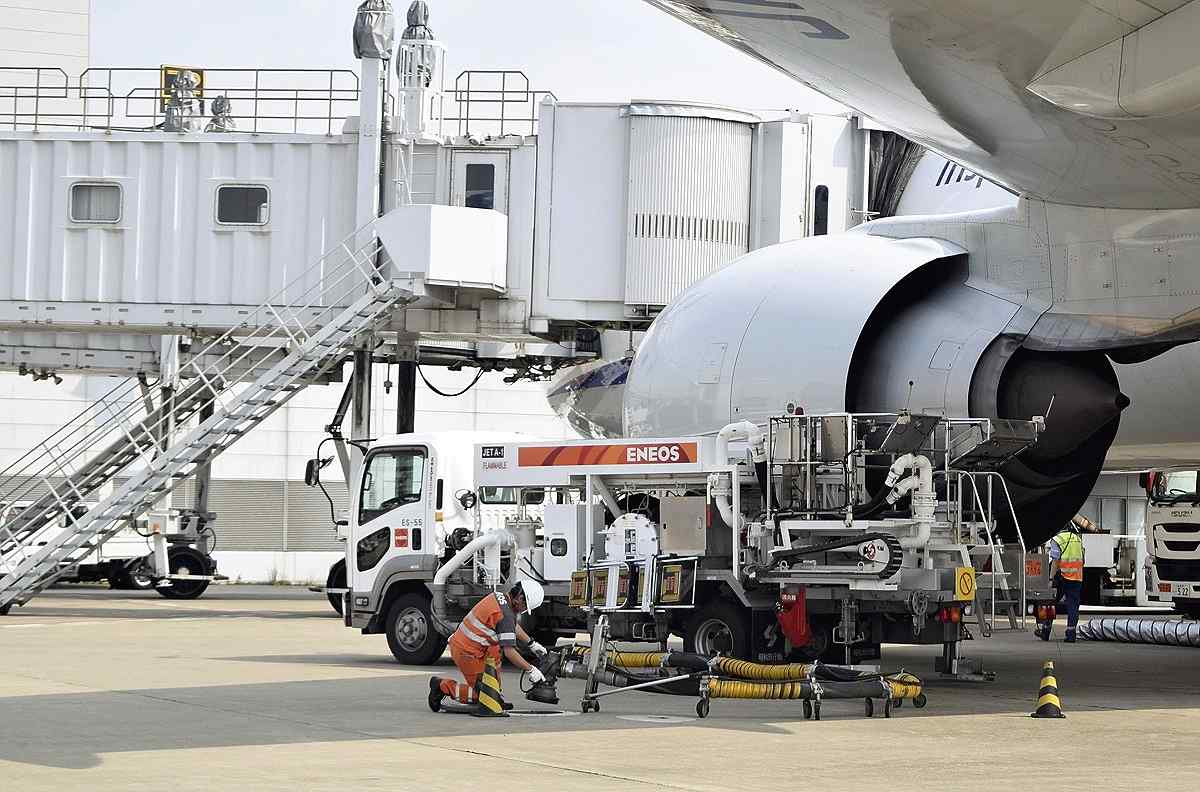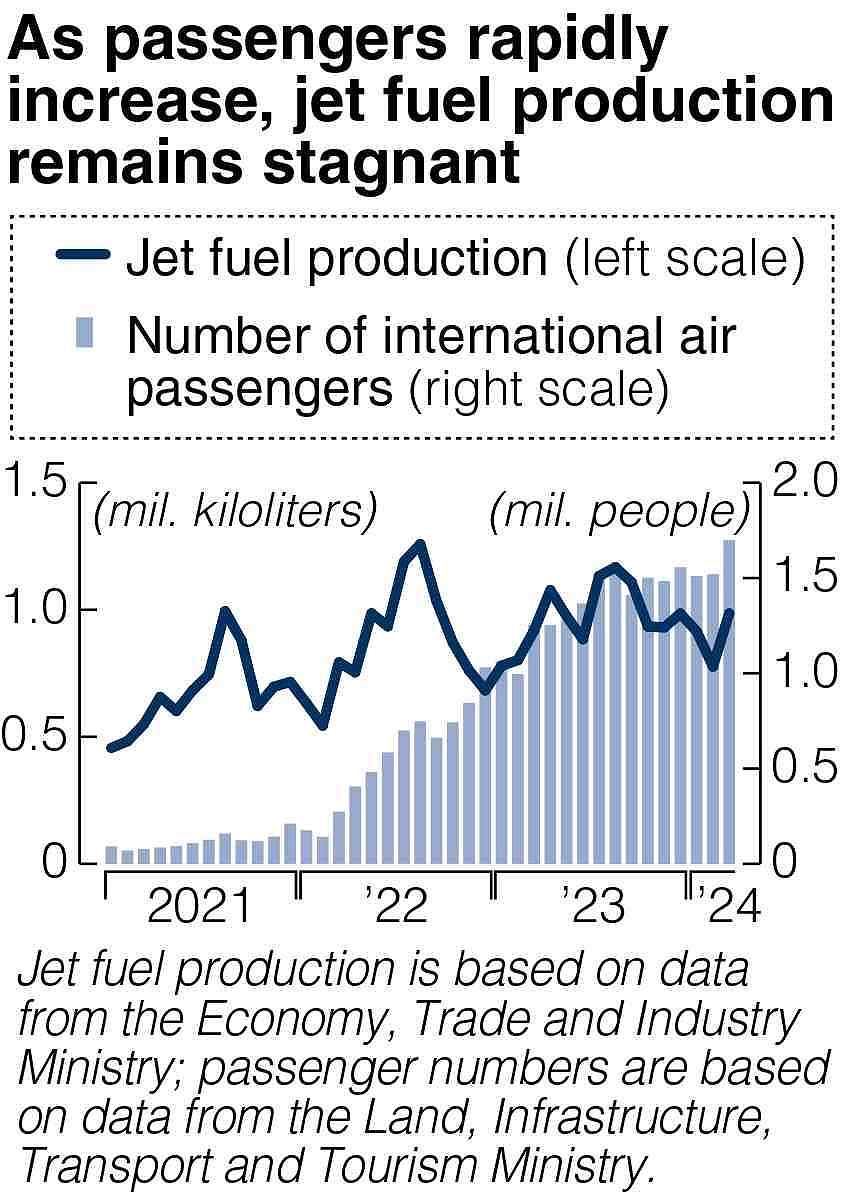Aviation Fuel Shortage Causes Problems at Regional Airports; Growing Demand, Lack of Workers to Transport

An aircraft is refueled at Haneda Airport in Tokyo.
14:13 JST, June 29, 2024
A shortage of aviation fuel is leaving airports around the country in a tight spot, especially regional airports.
Some airports have been forced to abandon plans for new routes as well as increasing the number of flights on existing routes due to lack of fuel, and some see delays in receiving shipments of fuel.
As demand for international flights increases amid the rapid recovery of travel to Japan, the government is hurriedly establishing countermeasures. However, the structural factors underlying the problems mean that the fuel shortage could hinder the country’s bid to become a top tourist destination.
Emergency measures discussed
On June 18, the first meeting of a council comprising members from both the public and private sectors was held to discuss the fuel shortage problems.
“As we are trying to attract foreign visitors to areas outside of the big cities, the situation now poses an even more serious problem than before,” said Kyoji Kuramochi, head of the Land, Infrastructure, Transport and Tourism Ministry’s Aviation Network Department.
The meeting was attended by officials of the transport ministry and the Natural Resources and Energy Agency as well as representatives from airline companies and oil wholesalers, among others. They started discussing emergency measures to tackle the problems.
Fuel shortages are already beginning to cause problems at airports across Japan.
At Hiroshima Airport in Hiroshima Prefecture, a foreign airline company reported in May that it was unable to procure fuel in Japan, making it difficult to complete a plan to increase its number of flights to the airport.
At Obihiro Airport in Hokkaido, some foreign airline companies, including Korean Air Lines Co., had to cancel plans to operate charter flights in July and August because they could not procure fuel in Japan.
Increasing the number of international flights gives a valuable opportunity for regional airports to attract more foreign tourists to their areas. “The shortage of fuel is causing serious damage to our economy,” said a Hiroshima prefectural government official.
Drops over 30%

Jet fuel, like gasoline, is one of many products of the crude oil refining process. In recent years, however, demand for gasoline and other petroleum products has slumped due to the progress of energy-saving measures and decarbonization. Consequently, jet fuel production is declining, with March production down more than 30% from five years ago.
Oil wholesalers are accelerating moves to consolidate and reduce the number of refineries. At their peak in 1983, these groups operated refineries in 49 locations, but the number has dropped to just 20 as of June. As a result, fuel must travel further to reach airports. But a labor shortage is making it difficult for both maritime and land transportation operators to flexibly respond to the situation.
In March, the number of international air passengers was 1.69 million, having reached over 80% of the figure in March 2019, before the COVID-19 pandemic started. The buoyant passenger demand is leading to high demand for jet fuel.
Both vessels and workers
The major oil wholesaler Eneos Holdings, Inc. is now declining new requests for supply of jet fuel from some airline companies and airports due to the tight market. While the company is considering increasing its production of jet fuel, it has to tackle other problems, too. “We have to not only cope with production but also secure to transport the fuel and airport workers to do the refueling,” a public relations official said.
The government has set a goal of replacing 10% of the fuel used by domestic airlines with Sustainable Aviation Fuel, or SAF, by 2030. But there are also problems with this next-generation fuel, including high costs and low production volume.
As the government aims to increase the number of foreign visitors to Japan to 60 million in 2030 — more than double the figure in 2023 — it is set to hurry to address these problems.
"Business" POPULAR ARTICLE
-

Keidanren Chairman Yoshinobu Tsutsui Visits Kashiwazaki-Kariwa Nuclear Power Plant; Inspects New Emergency Safety System
-

Imports of Rare Earths from China Facing Delays, May Be Caused by Deterioration of Japan-China Relations
-

University of Tokyo Professor Discusses Japanese Economic Security in Interview Ahead of Forum
-

Japan Pulls out of Vietnam Nuclear Project, Complicating Hanoi’s Power Plans
-

Govt Aims to Expand NISA Program Lineup, Abolish Age Restriction
JN ACCESS RANKING
-

Keidanren Chairman Yoshinobu Tsutsui Visits Kashiwazaki-Kariwa Nuclear Power Plant; Inspects New Emergency Safety System
-

Imports of Rare Earths from China Facing Delays, May Be Caused by Deterioration of Japan-China Relations
-

University of Tokyo Professor Discusses Japanese Economic Security in Interview Ahead of Forum
-

Japan Pulls out of Vietnam Nuclear Project, Complicating Hanoi’s Power Plans
-

Govt Aims to Expand NISA Program Lineup, Abolish Age Restriction























